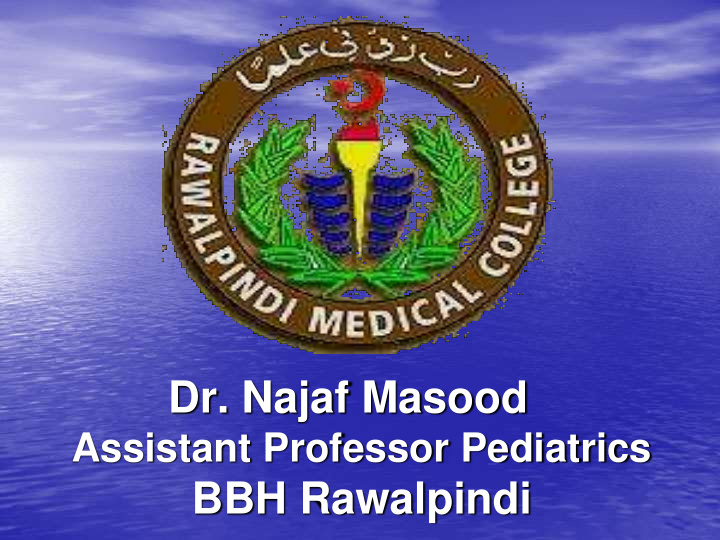



Dr. Najaf Masood Assistant Professor Pediatrics BBH Rawalpindi
Low Birth Weight
Normal birth weiht (NBW) • 2500-3900g
• Low Birth • Weight < 2500g • Very Low Birth • Weight <1500g • Extremely Low Birth Weight • <1000g • Incredibly Low Birth Weight • <750g
Incidence • Developed countries – 30% LBW-IUGR • Developing countries – 70% LBW-IUGR
Infant Classification by gestational (postmenstrual) age • Preterm < 37wks • Term 37 to 41 wks • Post term 42 wks
Intrauterine Growth Retardation • Also referred to as SGA • Birth weight is two standard below the mean for gestational age or as below tenth percentile
Symmetric IUGR • All three parameters are equally affected • Early in onset • Disease affecting fetal cell no. – Chromosomal – Genetic – Teratogenic – Infections – hypertension
Asymmetric IUGR • Normal head circumference • Late onset • Poor maternal nutrition • Late onset or exacerbation of maternal vascular disease
Etiology • Low socioeconomic status • Maternal under nutrition • Anemia • Inadequate prenatal care • Drugs misuse • Obstetric complication • Bad obstetric history • Maternal activity
Maternal Conditions • Under 16 Years • Chronic medical illness – hypertension – Cyanotic heart disease – Renal disease • infections
Fetal Conditions • Fetal Distress • Multiple gestation • Erythroblastosis • Non immune hydrops
Uterine • Uterine malformation – bicornuate • Uterine trauma • Cervical incompetence
Placental • Placental dysfunction • Placenta previa • Abruptio placenta
Others • Premature rupture of membrane • Polyhydroamnios • Iatrogenic • Trauma
Assessment of gestational Age • Rapid visual assessment • Ballard score • Obstetric information
Ballard score • Neurological maturity • Physical maturity
Problems of Prematurity • Respiratory • Perinatal depression • RDS • Apnea • Chronic lung disease
Neurological Problems including • Perinatal depression • Intracranial hemorrhage • Periventricular leukomalacia
Cardiovascular • Hypotension • hypovolemia • Cardiovascular dysfunction • vasodilatation • Patent ductus arteriosus
• Hematologic • Anemia • Hyperbilirubinemia • Nutritional • Gastrointestional • Factor for necrotizing enterocolitis
• Patent ductus arteriosus • Adequate oxygenation • Fluid restriction • Possible intermittent diuresis • Fluid and electrolyte therapy • Nutrition • Hyperbilirubinemia • Phototherapy • Exchange transfusion
• Metabolic • Renal • Temperature regulation • Immunologic • Ophthalmologic
Management of the premature infant • Delivery • Appropriately equipped and staffed hospital • Resuscitation and stabilization • Anticipation and prevention • Clear airway • Initiate breathing • Adequate oxygen delivery • Maintenance of proper temperature • Care of umbilical cord
Thermal regulation • Environmental temperature at which oxygen consumption is minimal yet sufficient to maintain body temperature • Maintain temp 36.5-37 o C • Humidity 40-60% – overhead radiant warmer, closed incubator
Oxygen therapy and assisted ventilation • Ways of administration – Head hood – Nasal prong – Continuous positive airway pressure • Risk of injury – Eyes – lung
Fluid Requirment • Term – 60-70ml/kg – 100-120ml/kg • Preterm – 70-80ml/kg – 150ml/kg
• Daily weight • Urine • Serum urea nitrogen • Serum sodium level
Total Parenteral Nutrition • Life saving for VLBW • CVP, peripheral vein • Aminoacid2.5-3 gm/kg/d • Glucose 10-15gm/kg/d • Intralipid 2-3gm/kg/d
Feeding • Method of feeding • Avoid fatigue & aspiration • Keep NPO – Respiratory distress – Hypoxia – Circulatory insufficiency – CNS depression – Severe immaturity
Nasogastric feeding • <1.5 kg – 10ml/kg/d – 20-30ml/kg/d • >1.5 kg – 20-25ml/kg/d
Oral feeding • 34 wks….>2kg • Synchronized process of sucking – Stong sucking effort – Coordination of swallowing • Trophic feeding
• Iron • Folic acid • Vitamin A, D, E, K • Calcium
Infection • Hand washing • Avoid over crowding • Skin care • Early enteral feeding • Broad spectrum – Nosocomial infection
Immunization • As in term • Pertussis vaccine is contraindicated in infants with possible or documented evolving neurological problem • Preterm infants with chronic respiratory distress should receive influenza immunization at 6 months of if they are not hospitalized
Long Term Problems of Prematurity • Developmental disability • Major handicaps • Sensory impairments • Minimal cerebral dysfunction • Retinopathy of Prematurity • Chronic lung disease • Poor growth • Increased frequency of congenital anomalies
Prognosis • Developed countries – 1.5-2 kg 95% survival • High risk of morbidity & mortality in IUGR • Higher incidence of rehospitalization in first 2 yr of life
Discharge criteria • Resolution of acute life threatening illness • Stable temp regulation • Gaining weight on oral feed • Free of apnea • Mother’s knowledge
Recommend
More recommend